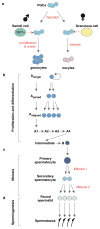Roles of RNA-binding Proteins and Post-transcriptional Regulation in Driving Male Germ Cell Development in the Mouse
- PMID: 27256385
- PMCID: PMC6219387
- DOI: 10.1007/978-3-319-29073-7_6
Roles of RNA-binding Proteins and Post-transcriptional Regulation in Driving Male Germ Cell Development in the Mouse
Abstract
Tissue development and homeostasis are dependent on highly regulated gene expression programs in which cell-specific combinations of regulatory factors determine which genes are expressed and the post-transcriptional fate of the resulting RNA transcripts. Post-transcriptional regulation of gene expression by RNA-binding proteins has critical roles in tissue development-allowing individual genes to generate multiple RNA and protein products, and the timing, location, and abundance of protein synthesis to be finely controlled. Extensive post-transcriptional regulation occurs during mammalian gametogenesis, including high levels of alternative mRNA expression, stage-specific expression of mRNA variants, broad translational repression, and stage-specific activation of mRNA translation. In this chapter, an overview of the roles of RNA-binding proteins and the importance of post-transcriptional regulation in male germ cell development in the mouse is presented.
Keywords: Alternative mRNA processing; Gametogenesis; Polyadenylation; Post-transcriptional regulation; RNA-binding proteins; Splicing; Translational control.
Figures


Similar articles
-
Germ granules and the control of mRNA translation.IUBMB Life. 2012 Jul;64(7):586-94. doi: 10.1002/iub.1039. Epub 2012 May 28. IUBMB Life. 2012. PMID: 22639345 Review.
-
Elevated levels of the polyadenylation factor CstF 64 enhance formation of the 1kB Testis brain RNA-binding protein (TB-RBP) mRNA in male germ cells.Mol Reprod Dev. 2001 Apr;58(4):460-9. doi: 10.1002/1098-2795(20010401)58:4<460::AID-MRD15>3.0.CO;2-F. Mol Reprod Dev. 2001. PMID: 11241784
-
Developmental stage- and germ cell-regulated expression of a calcium-binding protein mRNA in mouse Sertoli cells.Mol Reprod Dev. 1999 Nov;54(3):232-43. doi: 10.1002/(SICI)1098-2795(199911)54:3<232::AID-MRD4>3.0.CO;2-F. Mol Reprod Dev. 1999. PMID: 10497345
-
Testosterone regulates FGF-2 expression during testis maturation by an IRES-dependent translational mechanism.FASEB J. 2006 Mar;20(3):476-8. doi: 10.1096/fj.04-3314fje. Epub 2006 Jan 19. FASEB J. 2006. PMID: 16423876
-
Pathways of post-transcriptional gene regulation in mammalian germ cell development.Cytogenet Genome Res. 2003;103(3-4):210-6. doi: 10.1159/000076806. Cytogenet Genome Res. 2003. PMID: 15051941 Review.
Cited by
-
Novel roles for RNA binding proteins squid, hephaesteus, and Hrb27C in Drosophila oogenesis.Dev Dyn. 2023 Mar;252(3):415-428. doi: 10.1002/dvdy.550. Epub 2022 Nov 18. Dev Dyn. 2023. PMID: 36308715 Free PMC article.
-
Rbm14 maintains the integrity of genomic DNA during early mouse embryogenesis via mediating alternative splicing.Cell Prolif. 2020 Jan;53(1):e12724. doi: 10.1111/cpr.12724. Epub 2019 Dec 3. Cell Prolif. 2020. PMID: 31794640 Free PMC article.
-
hnRNPH1 recruits PTBP2 and SRSF3 to modulate alternative splicing in germ cells.Nat Commun. 2022 Jun 23;13(1):3588. doi: 10.1038/s41467-022-31364-7. Nat Commun. 2022. PMID: 35739118 Free PMC article.
-
Elongin B is a binding partner of the male germ cell nuclear speckle protein sperm-associated antigen 16S (SPAG16S) and is regulated post-transcriptionally in the testis.Reprod Fertil Dev. 2019 Apr;31(5):962-971. doi: 10.1071/RD18303. Reprod Fertil Dev. 2019. PMID: 30811962 Free PMC article.
-
Cstf2t Regulates expression of histones and histone-like proteins in male germ cells.Andrology. 2018 Jul;6(4):605-615. doi: 10.1111/andr.12488. Epub 2018 Apr 19. Andrology. 2018. PMID: 29673127 Free PMC article.
References
-
- Kleene KC. Patterns, mechanisms, and functions of translation regulation in mammalian spermatogenic cells. Cytogenet Genome Res. 2003;103:217–224. - PubMed
-
- Kleene KC. A possible meiotic function of the peculiar patterns of gene expression in mammalian spermatogenic cells. Mech Dev. 2001;106:3–23. - PubMed
MeSH terms
Substances
Grants and funding
LinkOut - more resources
Full Text Sources
Other Literature Sources

